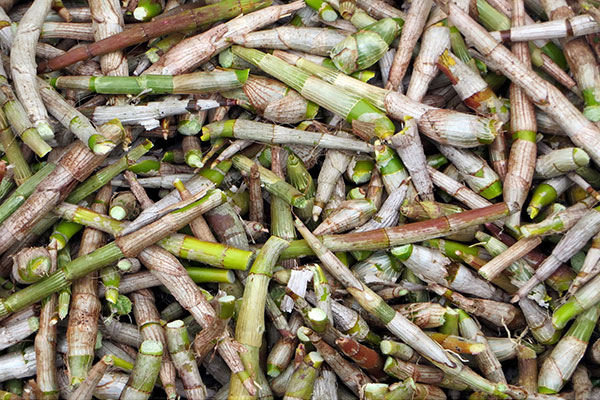Bamboo shoot is a newly sprouted cane of the bamboo plant, which is just formed underground and has a crisp texture. The inner soft part of the bamboo shoot is edible; the exterior is woody and has many layers and is removed before cooking.
Bamboo shoot is very rich in nutrients. It’s rich in dietary fiber and low on calorie and sugar content. Bamboo shoot has a source of proteins in the form of essential and semi-essential amino acids. It contains a good amount of minerals like potassium, manganese and copper but is low in fats and calories. It also stimulates the appetite.
Bamboo shoot is widely used in cooking in the North Eastern states of India like Meghalaya, Nagaland, Manipur and Assam. It has become a quintessential part of their cuisine. Many pickles and curries are made out of bamboo shoot.

Fermenting of bamboo shoot extends its shelf life and it has enhances the food safety as well. The Lactic Acid Bacteria present during the fermentation gives the bamboo shoot that special taste, texture and aroma that we know of. Young and tender bamboo shoots are fermented usually during the months of May-June. The tribals of North East India have similar ways of fermenting bamboo shoot. The tribals from Nagaland and Meghalaya still follow two age-old traditional practices in fermenting bamboo shoot. So let’s have a look on these two practices.
- KHOH (CONICAL BASKET) METHOD: Khoh is a Khasi word meaning basket. In this first method, the bamboo shoots are collected and the woody exterior is removed. They are then cut into small pieces and put into the conical basket. Then fresh leaves are taken and tied all around to cover the outside of the basket. The top of the basket is covered too with leaves. A small opening is made from the bottom of the basket to drain the juice of the bamboo shoot into a container at the bottom. The fermentation period is kept for 3 to 4 months. It is then ready for consumption.
- TYNDONG (HOLLOW BAMBOO) METHOD: Here, the word Tyndong means hollow bamboo in Khasi. In this method, hollow internodes of bamboos are used with one end of the node removed. The peeled and cut bamboo shoots are put inside the hallow bamboo and the open end is closed with banana leaves. The fermentation period for this method is the same as the pervious method. Now it’s fit for consumption.
Out of these two traditional practices, the Khoh Method is considered the best, as the acidic content of the bamboo shoot is lessened when the juice is drained out. Therefore it is healthier for consumption.

